If you have a blog or are thinking of starting one, then you know how important search engine optimization (or SEO) is for the success of your blog. While learning SEO might sound like a daunting task, there are tools out there that can really simplify the process, such as RankIQ. In this post I will share my honest RankIQ review after using this SEO tool for my blog over the last year. Hopefully this review from a fellow blogger can help you decide if this is the right SEO tool for you. It’s This post contains affiliate links. When you make a purchase I may get a small commission at no extra cost to you. Find out more here.
Are you starting a blog? Check out these helpful resources:
- Web hosting: BigScoots
- Keyword research: KeySearch
- SEO tool for blogging: RankIQ
- Travel affiliate platform for bloggers: Stay22 (get $100 when you get to 100 bookings if you sign up through this link)
What is RankIQ?
Rank IQ is a valuable tool that helps you write optimized blog posts that rank on the first page of Google.
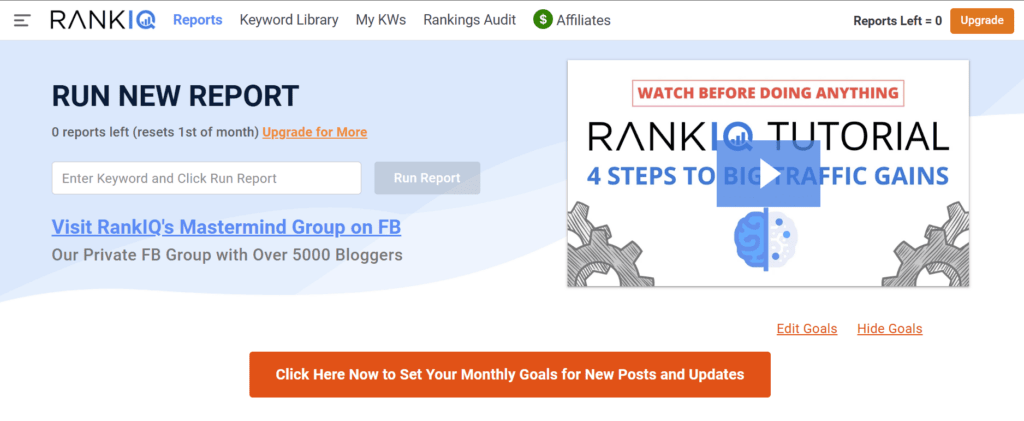
It is an SEO tool that was built by Brandon Gaille, a blogger and host of The Blogging Millionaire, for bloggers.
This means that this powerful tool was optimized to help bloggers rank on the 1st page of Google to get traffic to their blogs.
How does RankIQ work?
Rank IQ has two components: a keyword library and a content optimizer. Let me tell you what I think about each of them.
RankIQ’s keyword library
RankIQ has a keyword library that is broken down by niche. So if you’re a travel blogger you can search for keywords in their library for the broad Travel niche, as well as for sub-niches such as Travel Bali, Travel European Day Trips, Travel Packing and Luggage and so on.
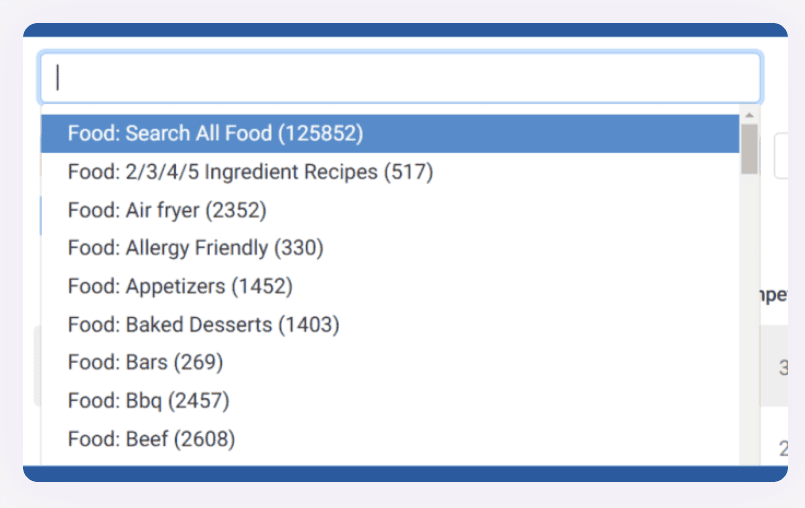
Then for each keyword in this library you can see a competition score, the number of visits per year, and the time to rank.
The competition score tells you how competitive that keyword is. If you have a newer blog you should go for lower competition keywords. But you don’t have to do any guessing because RankIQ suggests what competition score you should pick based on your domain authority (or DA).
The number of visits per year is an estimated number that can give you a sense of search volume aka how many people search that term on Google. The higher that number, the more traffic you can get if you rank for that keyword.
The time to rank is a RankIQ metric that helps you gauge how fast your blog post can rank on Google’s first page. They have 4 rank speed categories: ultrafast, very fast, fast, and average.
As a rule of thumb ultrafast keywords will rank in about 3 months, very fast in 3-6 months, fast in 6-12 months, and average in 12+ months. Of course, this is not a hard rule and ranking speed might be different.
My opinion of RankIQ’s keyword library
My honest opinion about their keyword research library? It’s good, but it doesn’t have enough keywords in it. So if this is the only tool you use in your keyword research process you will be very limited. You won’t find enough low competition topics to write about for your niche.
That’s because RankIQ was not built to be a keyword tool, but a content optimization tool.
The keyword research tool I use is Keysearch. It has a more comprehensive list of keywords. And it does a great job at showing me both the competition and the volume of a keyword. At the same time, it’s one of the most affordable options out there. The price quality ratio is very good.
When you combine Keysearch with RankIQ magic happens and you see your traffic grow.
RankIQ’s content optimizer
Now the content optimizer is RankIQ’s top feature. So what is this and how does it work?
When you sign up for RankIQ you get 16 reports per month. Once you pick the keyword you want to write about you come to RankIQ and you run a report on it.
The report then shows you how long your blog post needs to be and it grades your SEO title and your overall post.
It also gives you a competition score and an estimated time to rank. This is the same thing I described in the RankIQ’s keyword library section of this post.
The length part is very simple. It analyzes the top 10 articles that rank on the first page of Google and then it comes up with a suggested length for your blog post. This way you have a higher chance of ranking.
The tool also does title analysis. It tells you what keywords you should use in your title and it will also tell you how long your title should be.
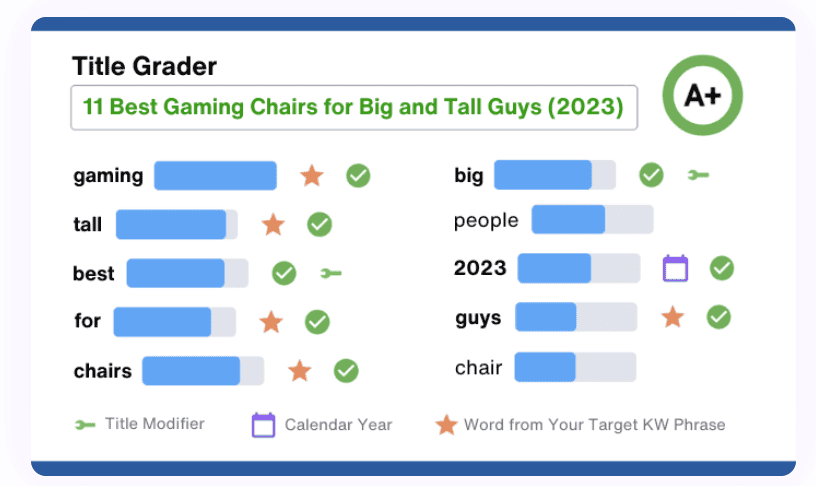
It scores your title on a scale of A+ to F. Once you get to an A+ grade you know you have an optimized title.
Then you can write your blog post in RankIQ. On the right hand side you will have a column with a bunch of keywords you should sprinkle throughout your blog post.
The tool grades your post based on how many of these keywords you used. It scores your post on a scale of F to A++. The tool also tells you which letter grade you should hit to have a better chance of ranking high on Google.
For some posts the grade you need to hit can be as low as B+, while for other posts you need to get to A++.
Step-by-step guide of how to use RankIQ’s content optimizer
This might sound complicated, but in reality it’s super simple. So let’s go over an example.
Let’s assume you did your keyword research in Keysearch and “Bali 3 day itinerary” is your target keyword.
You then come to RankIQ and you type “Bali 3 day itinerary” in the reports section of the tool and then press the “run report” button.
In less than a minute you get your report. The report has 2 tabs: SEO report and optimizer.
In the SEO report tab you can see the grade you need to hit with your post and the minimum word count, as well as the competition score and time to rank.
So for this example let’s say you see A++ as your content grade, 3457 word count, 18 competition and ultra fast time to rank.
So that means that you need to use as many keywords as possible from the list the tool gives you until you get to A++. When you start writing you will see an F grade. Then as you use more relevant keywords the grade will increase to D-, then D, and so on until you get to A++.
The word count means that for this example you would have to write at least 3457 words to have the best chance to rank on the first page.
A competition score of 18 has low-medium competition usually. Hence why the estimated time to rank would be ultra fast.
So if you write your blog post with an optimized SEO title, optimized content, and optimized length according to RankIQ’s suggestions, you did everything you could to try to be on the first page of Google search results.
My opinion of RankIQ’s content optimizer
I love it! It’s such a great tool. It has a user-friendly interface, so even if you’re not a tech-savvy person you can still easily use this tool.
You can use RankIQ for both old blog posts and new posts. So even if you started your blog a while ago and you just find out about RankIQ you can run the reports on old posts and you can update them so they are more optimized for search engines.
Ever since I subscribed to RankIQ I don’t have to spend a lot of time to make sure my posts are optimized for search engine rankings. This tool was a game changer for me and it saves me precious time that I can use to do something else.
Can RankIQ be used for every blogging niche?
Yes, absolutely. It can be used by travel bloggers, food bloggers, fashion bloggers, and any other niche.
At the end of the day you just need to run RankIQ reports for your target keywords. It doesn’t matter which niche these keywords are in.
The tool does its job no matter which specific topic you write about.
How does RankIQ compare with other SEO tools?
The other tools that bloggers usually use for optimizing the SEO of new blog posts are Ahrefs, SEMRush, and Surfer.

RankIQ is the highest-rated SEO tool in the world based on a customer satisfaction survey ran in 2023.
They also won 19 international awards as the best SEO software.
RankIQ was built for bloggers and small businesses, while all other tools were built for SEO experts. At the same time RankIQ is the only tool that’s run by bloggers.
RankIQ is the most affordable SEO tool on the market. You won’t find anything cheaper.
What is the cost of RankIQ?
Speaking of the price, RankIQ costs only $49 per month and you get 16 reports per month.
On the other hand, Surfer costs $89 per month, Ahrefs $99, and SEMRush a whopping $129 per month.
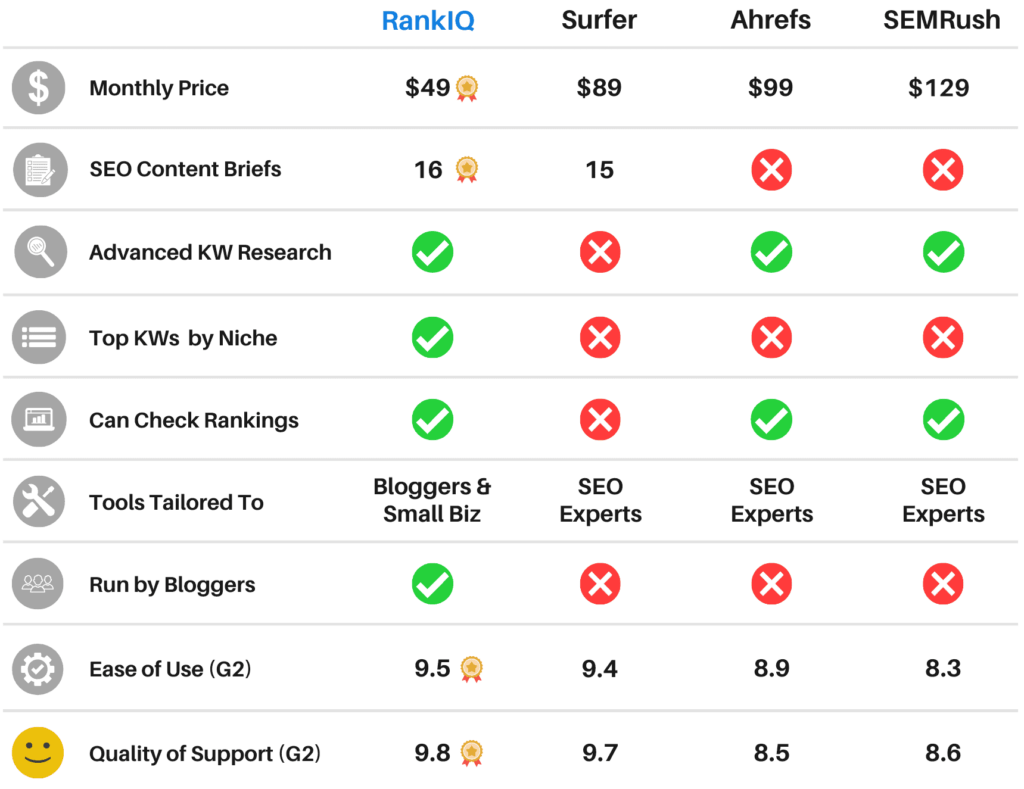
And if $49 per month is still too much for you, they also offer an 8 reports per month plan that costs only $29 per month.
In order to access this lower cost plan you need to sign up for the $49/month plan and then after a month you can email their customer service and they will help you downgrade your plan.
I mean $29 vs $129 per month is a huge difference. RankIQ is by far the winner in the price category.
And within the same price you get access to the RankIQ Mastermind Group on Facebook. This is a group for bloggers who use RankIQ. You can ask questions about blogging here. And you can learn a ton from your fellow bloggers.
And one of the coolest things about being in this Facebook group is that you get access to an excel spreadsheet of all blogs that use RankIQ that accept guest posts. Which is so helpful for new blogs that need to secure a few high-quality backlinks to grow their domain authority. The RankIQ community is awesome and very friendly and helpful.
What are your results using RankIQ?
Now that you understand what RankIQ is and how it compares to other SEO tools out there, let me tell you about my personal experience using this tool.
Because at the end of the day you need to make sure a tool like this can help you rank such that you get the organic traffic you want.
My blogging history
Here is my story. I started this blog in January 2024. I had no blogging experience. This is my first and only blog.
At that time I was doing travel content creation on Instagram and I had about 10K followers on there. I knew I wanted to quit corporate and do content creation full time.
But with the ever-changing social media algorithms I wanted to diversify my income streams. So I thought starting a blog would be a good idea since the traffic sources are different.
For a blog the main traffic source is Google (or Pinterest, depending on your niche), while for Instagram you just need to adapt to what the latest algorithm wants from you.
I searched on Google how to start a blog, I read a few articles on the first page of search results, and I started taking the steps towards building my blog.
Everything I did, I did it myself. I didn’t buy any course, I didn’t hire any tech support, I don’t have any ghost writers writing my blog posts. This blog is truly just me.
I describe all the steps I took to build my blog in this article. If you’re a newbie I hope what I learned over the past year can help you too.
Blog vs social media monetization
Starting this blog was one of my best decisions. Even though I was also able to grow on Instagram over the last year and I am now close to 80K followers, I still think starting a blog was the smart thing to do.
That’s because my blog is my most predictable and stable income source as a full-time solo travel content creator. I monetize my blog through ads and affiliate marketing. I know that as long as my blog’s traffic grows my income grows. So I always know the minimum amount I am going to make in a month through my blog.
While I also monetize my Instagram, there is a larger month-to-month variation in income there compared to my blog. Some months I have multiple paid partnerships on Instagram, but then the following month I might have zero. And you constantly have to pitch brands, hotels and tourism boards to get those paid partnerships.
My blog’s growth – clicks per day
I started my blog in January 2024. For the first three months I saw almost no organic traffic. I might have had days with 1-5 clicks from Google, but it was minimal.
I started using RankIQ in February 2024, one month after I started my blog. Basically all my blog posts are SEO optimized using RankIQ. And I did this from the very beginning.
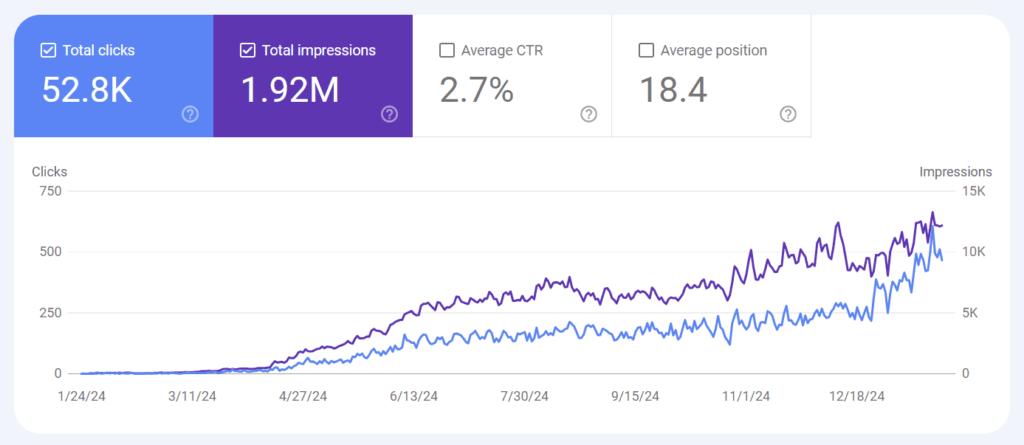
In April I started to see my traffic increase. I was already at 20-30 clicks per day.
Then my traffic continued to pick up until I reached about 150-200 clicks per day. I then had a plateau period for a few months. I think it was due to a Google algorithm update that affected a lot of blogs.
But once that update was over my blog started growing again and I am currently around 500-600 clicks per day.
When I talk about clicks per day I only mean organic traffic from Google. Basically what you see in Google Search Console.
My blog’s growth – sessions per month
Now if we switch to number of sessions, I had about 1.5K sessions per month in April 2024. And I reached 10K sessions per month in December 2024. That’s when I applied to Journey by Mediavine and I got in.
At the end of January 2025 I am at 20K sessions per month and my traffic is growing every day. I hope to reach 50K sessions per month in a few months so I can join the full Mediavine program.
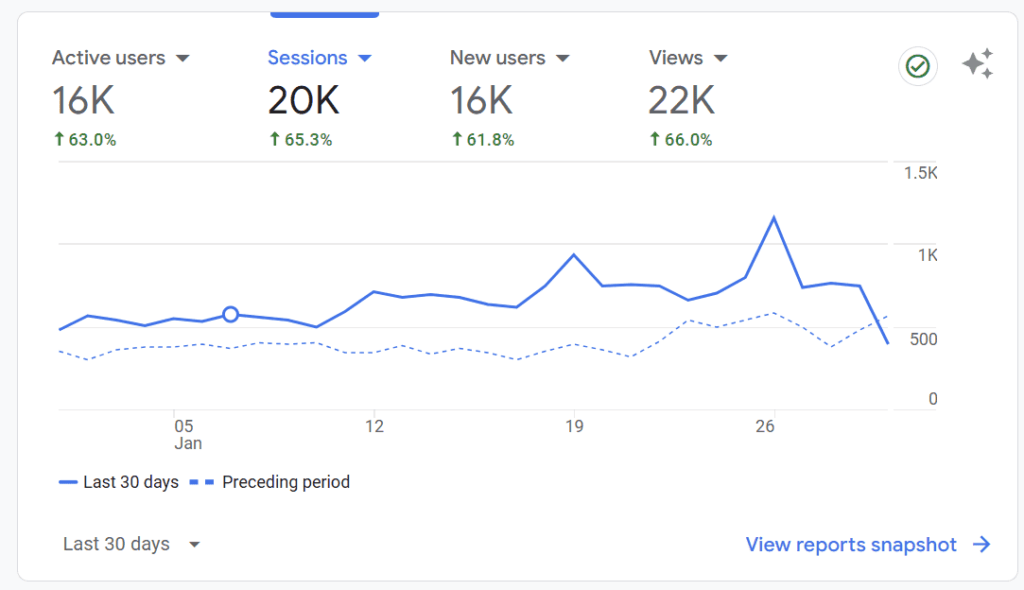
Hopefully these numbers give you a benchmark for a new blog. I am very proud of getting these results, especially since I am a self-taught blogger and I had no help in doing all of this.
I do believe that RankIQ played a significant part in me hitting this traffic numbers so fast. RankIQ will be my SEO tool as long as I have this blog because it’s truly helpful.
What are other people’s results using RankIQ?
I love data and numbers. A recent 1-year study of 2363 Mediavine blogs found that the Mediavine blogs using RankIQ increased their Google traffic 468% more than the Mediavine blogs not using RankIQ.
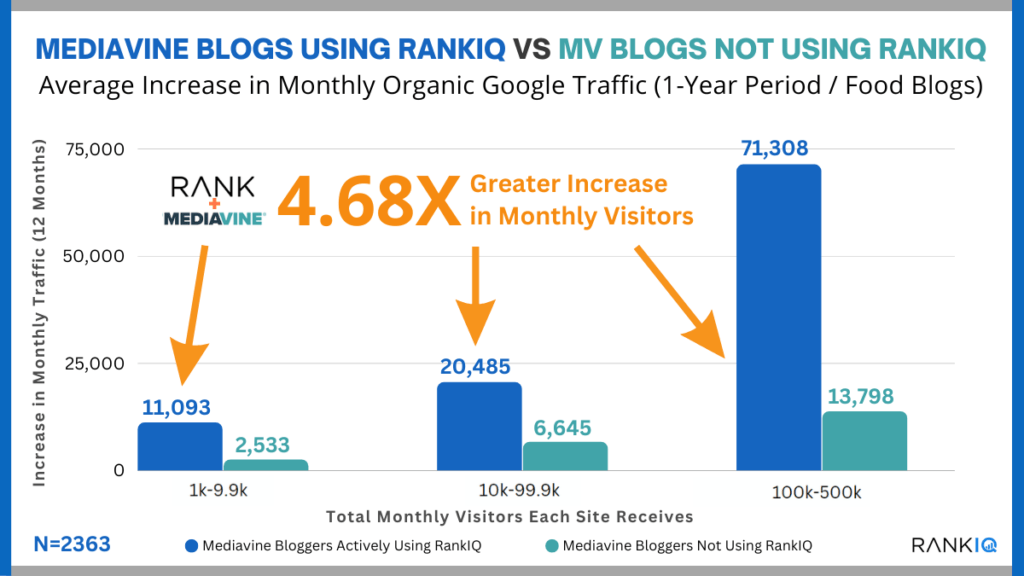
In case you’re not familiar with Mediavine, they are a premium ad network. Basically every blogger is working towards getting to 50K sessions per month so they can apply for Mediavine.
The RPM (revenue per 1,000 views) you get when you are part of a premium ad network is much higher compared to lower-tier networks. Which means that you will make more money from ads.
But back to the study. I love this study because it analyzed a large number of blogs. So this is not just my result using RankIQ or a handful of people’s results. This is thousands of people all experiencing the same growth. Which means that the tool works and is reliable for every blogger.
And I also liked that they included only Mediavine blogs because that means that these are high-quality blogs since the vetting process to get into Mediavine is a very rigorous one. And it’s nice to see the difference in traffic growth for these blogs.
I don’t know about you, but these results motivate me. This is proof that I am using the right tools to grow my blog and that one day I can be part of those Mediavine blogs included in analyses like this one.

Ioana was born and raised in Romania, lived in NYC for 14 years, and is now back in Romania. She fell in love with traveling when she was little and used to visit her aunt in Vienna. Then in high school she was able to visit Siberia, Turkmenistan, Istanbul, and Tokyo through chemistry competitions. As an adult she started to travel solo once she turned 30 and visited 20+ countries so far. Ioana is a full time travel blogger and content creator with an audience of 75K+ people on Instagram. She loves to share travel recommendations and tips.
